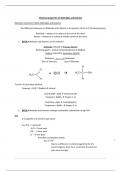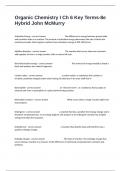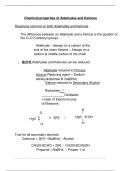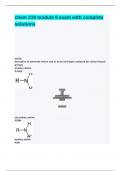Carbon nucleophiles - Study guides, Class notes & Summaries
Looking for the best study guides, study notes and summaries about Carbon nucleophiles? On this page you'll find 77 study documents about Carbon nucleophiles.
Page 4 out of 77 results
Sort by

-
PSU Chem 210 Final Review Questions with Correct Solutions | Graded A+
- Exam (elaborations) • 3 pages • 2023
-
Available in package deal
-
- $8.99
- + learn more
E2 Reaction - One-Step with no intermediates, Base takes off proton + LG leaves with double bond formation. What type of carbons do E2 rxns favor? - Tertiary What is a Zaitsev product? - Double bond formation on more substituted carbon What is a Hoffman product? - Double bond formation on less substituted carbon When using a stericallly hindered base (t-BuOK, LDA), which product is more favorable? - Hoffman When using Eto- or less sterically hindered base, which pro...

-
Chem 210 Exam 3 questions and answers
- Exam (elaborations) • 11 pages • 2023
-
Available in package deal
-
- $14.99
- + learn more
what factors explain the outcomes of reactions? hybridization, delocalization, eN, atom density what is a leaving group? - group of atom(s) that can be stable on its own - eN atoms that are good LG also make strong acids what is the α carbon? C directly attached to leaving group what are β Cs? β Hs? βC: C(s) attached to α carbon βH: H(s) attached to βC what is a LB? is it a nucleophile or electrophile? lewis base, nucleophile what is nucleophilic ...

-
Chemical properties of Aldehydes and Ketones Reactions common to both Aldehydes and Ketones
- Exam (elaborations) • 45 pages • 2024
-
- $11.49
- + learn more
Chemical properties of Aldehydes and Ketones Reactions common to both Aldehydes and Ketones The difference between an Aldehyde and a Ketone is the position of the C=O (Carbonyl group). Aldehyde – always on a carbon at the end of the chain Ketone – Always on a carbon at middle carbon of the chain 1. BOTH Aldehydes and Ketones can be reduced Aldehyde reduced to Primary Alcohol Reducing agent = Sodium tetrahydroborate III (NaBH4) Ketone reduced to Secondary Alcohol Reduction Oxidisatio...

-
Chem 210 Exam 3 Questions with Correct Solutions| Rated A+
- Exam (elaborations) • 9 pages • 2023
-
Available in package deal
-
- $10.99
- + learn more
what factors explain the outcomes of reactions? - hybridization, delocalization, eN, atom density what is a leaving group? - - group of atom(s) that can be stable on its own - eN atoms that are good LG also make strong acids what is the α carbon? - C directly attached to leaving group what are β Cs? β Hs? - βC: C(s) attached to α carbon βH: H(s) attached to βC what is a LB? is it a nucleophile or electrophile? - lewis base, nucleophile what is nucleophilic ...

-
Industrial Applications of Organic Chemistry
- Exam (elaborations) • 14 pages • 2024
-
- $8.99
- + learn more
Unit 28: Industrial Applications of Organic Chemistry Unit code: H/502/5573 QCF Level 3: BTEC National Credit value: 10 Guided learning hours: 60 Aim and purpose The aim of this unit is to familiarise learners with the structure, naming and properties of a range of organic compounds and to investigate the industrial uses of these compounds. Unit introduction The majority of the substances we use every day are, or contain, organic compounds. Pharmaceuticals such as aspirin and parac...

-
Organic Chemistry I Ch 6 Key Terms-8e Hybrid John McMurry Questions And Answers Graded A+.
- Exam (elaborations) • 5 pages • 2024
-
Available in package deal
-
- $12.99
- + learn more
Activation Energy - correct answer The difference in energy between ground state and transition state in a reaction. The amount of activation energy determines the rate at which the reaction proceeds. Most organic reactions have activation energy of 400-100 kj/mol Addition Reaction - correct answer The reaction that occurs when two reactants add together to form a a single product with no atoms left over. Bond dissoc...

-
AAMC MCAT Practice Exam 1 questions fully solved & verified for accuracy 2024
- Exam (elaborations) • 80 pages • 2024
- Available in package deal
-
- $15.99
- + learn more
In the chromatography of the reaction mixture, water absorbed on cellulose functioned as the stationary phase. What was the principal factor determining the migration of individual components in the sample? A) Hydrogen bonding B) Solute concentration C) Stationary phase concentration D) Thickness of paper A) Hydrogen bonding The answer to this question is A because the relative amount of hydrogen bonding to the stationary phase will determine the relative rate of migration of the vario...

-
MCAT Official Prep Chemistry Question Pack ALL SOLUTION 100% CORECT AID GRADE A+
- Exam (elaborations) • 8 pages • 2024
-
- $11.19
- + learn more
Question 2: If an archaebacterial species lives in a pool that is 0.01 M HCl(aq), what is the pH of the water? A. 12 B. 6 C. 2 D. 0.01 Correct answer: C The pH of a solution is defined as -log[H+] Since HCL completely dissociates in water, the concentration of HCl is equal to the concentration of H+ Question 9: If a leak develops in the vacuum distillation apparatus, the boiling points of the two components of caraway seed oil will: A. both increase. B. both decrease. C. both re...

-
Chemical properties of Aldehydes and Ketones Reactions common to both Aldehydes and Ketones The difference between an Aldehyde and a Ketone is the position of the C=O (Carbonyl group). Aldehyde – always on a carbon at the end of the chain Ketone – Always
- Exam (elaborations) • 83 pages • 2024
-
- $15.99
- + learn more
Chemical properties of Aldehydes and Ketones Reactions common to both Aldehydes and Ketones The difference between an Aldehyde and a Ketone is the position of the C=O (Carbonyl group). Aldehyde – always on a carbon at the end of the chain Ketone – Always on a carbon at middle carbon of the chain 1. BOTH Aldehydes and Ketones can be reduced Aldehyde reduced to Primary Alcohol Reducing agent = Sodium tetrahydroborate III (NaBH4) Ketone reduced to Secondary Alcohol Reduction Oxid...

-
chem 219 module 6 exam with complete solution
- Exam (elaborations) • 10 pages • 2024
-
Available in package deal
-
- $11.99
- + learn more
R-NH2 R-NH2 Choose matching term 1 primary amine 2 higher than alkanes lower than alcohols 3 two main steps of reductive amination? 4 cyclohexylamine Don't know? Terms in this set (124) Original amine derivative of ammonia where one or more hydrogen replaced by carbon-based groups primary amine R-NH2 Previous Play Next Rewind 10 seconds Move forward 10 seconds Unmute 0:01 / 0:15 Full screen Brainpower Read More secondary amine R2NH tertia...

How much did you already spend on Stuvia? Imagine there are plenty more of you out there paying for study notes, but this time YOU are the seller. Ka-ching! Discover all about earning on Stuvia


